belt INFINITI G35 2006 Manual PDF
[x] Cancel search | Manufacturer: INFINITI, Model Year: 2006, Model line: G35, Model: INFINITI G35 2006Pages: 344, PDF Size: 6.81 MB
Page 229 of 344
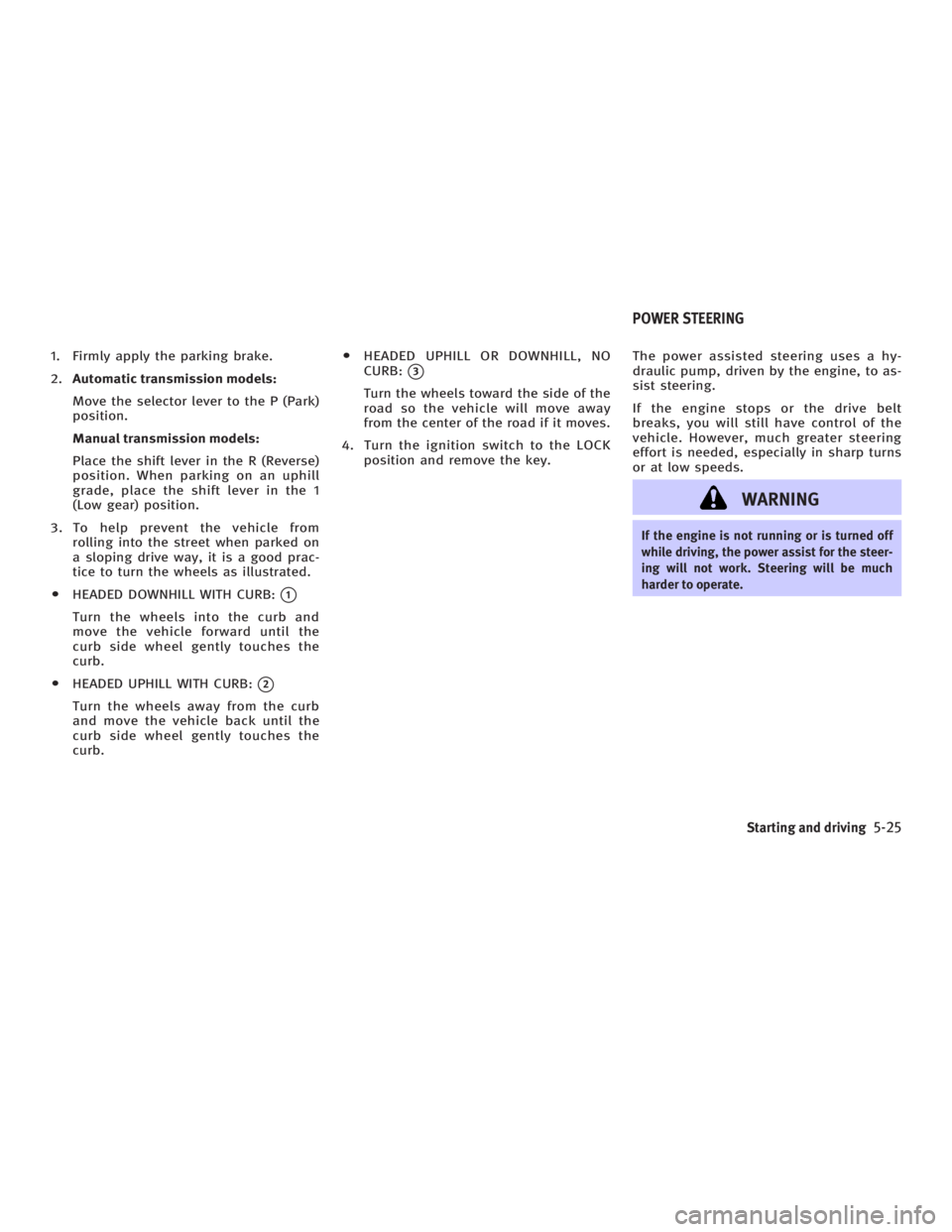
1. Firmly apply the parking brake.
2. Automatic transmission models:
Move the selector lever to the P (Park)
position.
Manual transmission models:
Place the shift lever in the R (Reverse)
position. When parking on an uphill
grade, place the shift lever in the 1
(Low gear) position.
3. To help prevent the vehicle from
rolling into the street when parked on
a sloping drive way, it is a good prac-
tice to turn the wheels as illustrated.
O HEADED DOWNHILL WITH CURB:
q 1
Turn the wheels into the curb and
move the vehicle forward until the
curb side wheel gently touches the
curb.
O HEADED UPHILL WITH CURB:
q 2
Turn the wheels away from the curb
and move the vehicle back until the
curb side wheel gently touches the
curb. O HEADED UPHILL OR DOWNHILL, NO
CURB:
q 3
Turn the wheels toward the side of the
road so the vehicle will move away
from the center of the road if it moves.
4. Turn the ignition switch to the LOCK
position and remove the key. The power assisted steering uses a hy-
draulic pump, driven by the engine, to as-
sist steering.
If the engine stops or the drive belt
breaks, you will still have control of the
vehicle. However, much greater steering
effort is needed, especially in sharp turns
or at low speeds.
WARNING If the engine is not running or is turned off
while driving, the power assist for the steer-
ing will not work. Steering will be much
harder to operate.POWER STEERING
Starting and driving
5-25
w 06.1.4/V35-D/V5.0
X
Page 247 of 344
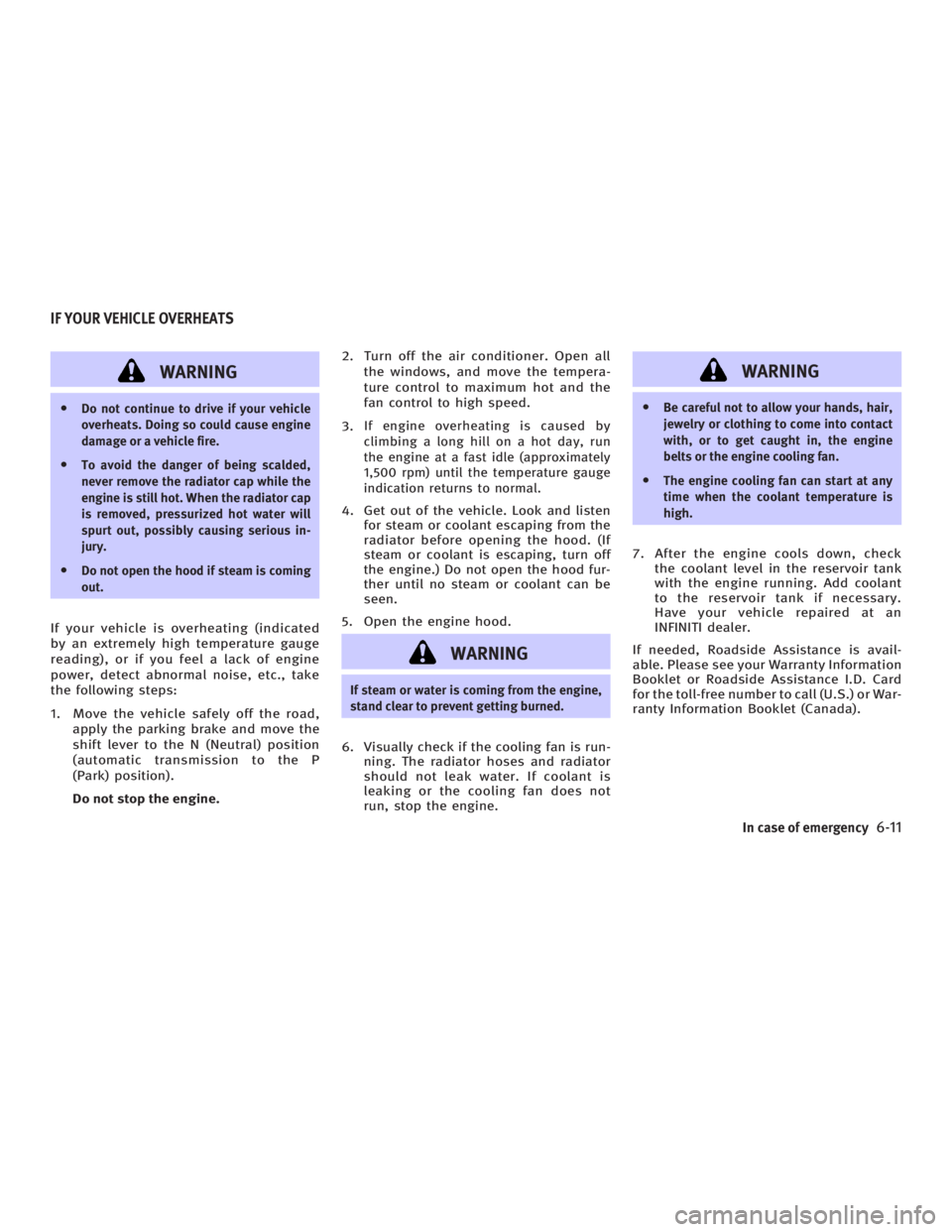
WARNINGO Do not continue to drive if your vehicle
overheats. Doing so could cause engine
damage or a vehicle fire.
O To avoid the danger of being scalded,
never remove the radiator cap while the
engine is still hot. When the radiator cap
is removed, pressurized hot water will
spurt out, possibly causing serious in-
jury.
O Do not open the hood if steam is coming
out.
If your vehicle is overheating (indicated
by an extremely high temperature gauge
reading), or if you feel a lack of engine
power, detect abnormal noise, etc., take
the following steps:
1. Move the vehicle safely off the road,
apply the parking brake and move the
shift lever to the N (Neutral) position
(automatic transmission to the P
(Park) position).
Do not stop the engine. 2. Turn off the air conditioner. Open all
the windows, and move the tempera-
ture control to maximum hot and the
fan control to high speed.
3. If engine overheating is caused by
climbing a long hill on a hot day, run
the engine at a fast idle (approximately
1,500 rpm) until the temperature gauge
indication returns to normal.
4. Get out of the vehicle. Look and listen
for steam or coolant escaping from the
radiator before opening the hood. (If
steam or coolant is escaping, turn off
the engine.) Do not open the hood fur-
ther until no steam or coolant can be
seen.
5. Open the engine hood.
WARNING If steam or water is coming from the engine,
stand clear to prevent getting burned.
6. Visually check if the cooling fan is run-
ning. The radiator hoses and radiator
should not leak water. If coolant is
leaking or the cooling fan does not
run, stop the engine. WARNING O Be careful not to allow your hands, hair,
jewelry or clothing to come into contact
with, or to get caught in, the engine
belts or the engine cooling fan.
O The engine cooling fan can start at any
time when the coolant temperature is
high.
7. After the engine cools down, check
the coolant level in the reservoir tank
with the engine running. Add coolant
to the reservoir tank if necessary.
Have your vehicle repaired at an
INFINITI dealer.
If needed, Roadside Assistance is avail-
able. Please see your Warranty Information
Booklet or Roadside Assistance I.D. Card
for the toll-free number to call (U.S.) or War-
ranty Information Booklet (Canada).IF YOUR VEHICLE OVERHEATS
In case of emergency
6-11
w 06.1.4/V35-D/V5.0
X
Page 253 of 344
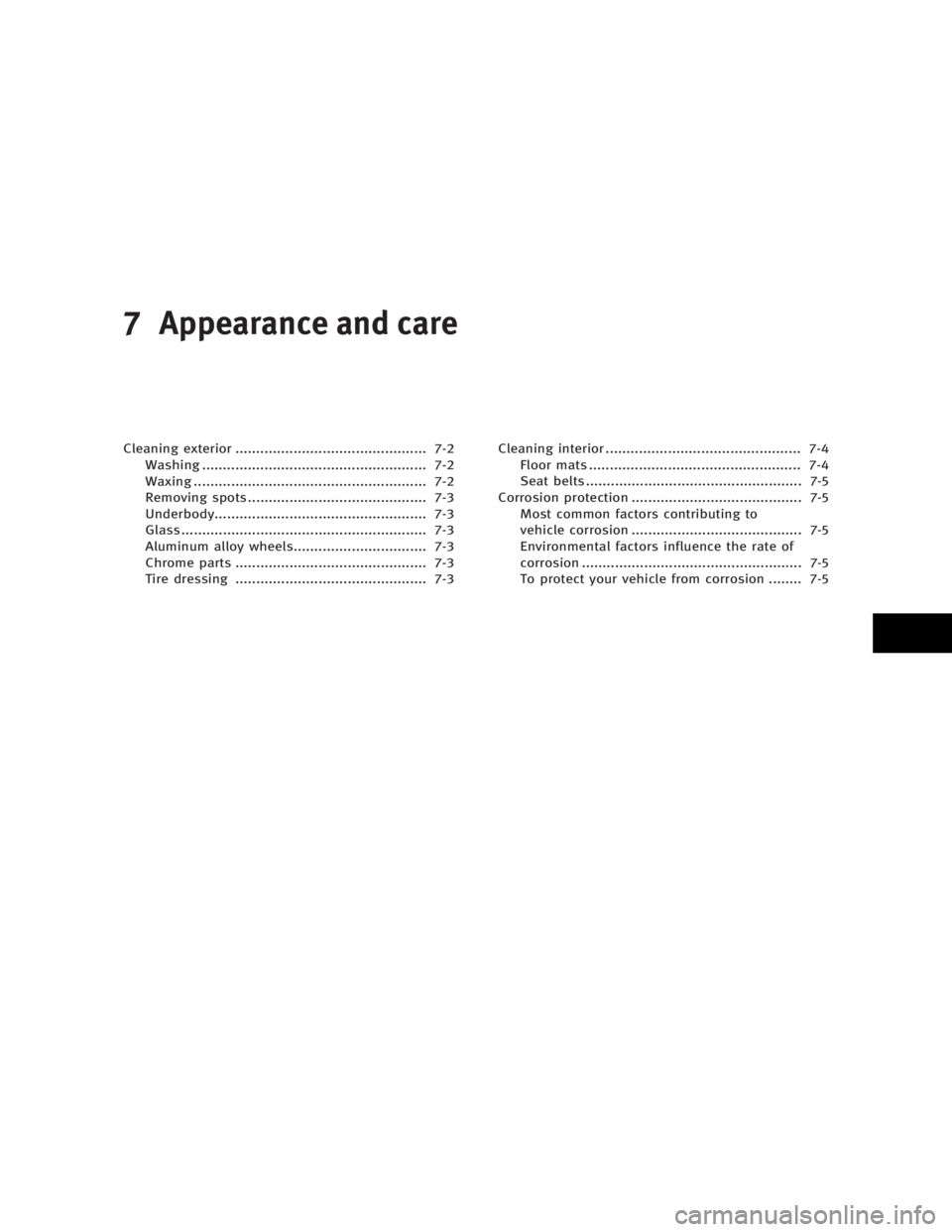
7 Appearance and care Cleaning exterior .............................................. 7-2
Washing ...................................................... 7-2
Waxing ........................................................ 7-2
Removing spots ........................................... 7-3
Underbody................................................... 7-3
Glass ........................................................... 7-3
Aluminum alloy wheels................................ 7-3
Chrome parts .............................................. 7-3
Tire dressing .............................................. 7-3 Cleaning interior ............................................... 7-4
Floor mats ................................................... 7-4
Seat belts .................................................... 7-5
Corrosion protection ......................................... 7-5
Most common factors contributing to
vehicle corrosion ......................................... 7-5
Environmental factors influence the rate of
corrosion ..................................................... 7-5
To protect your vehicle from corrosion ........ 7-5
w 06.1.4/V35-D/V5.0
X
Page 257 of 344
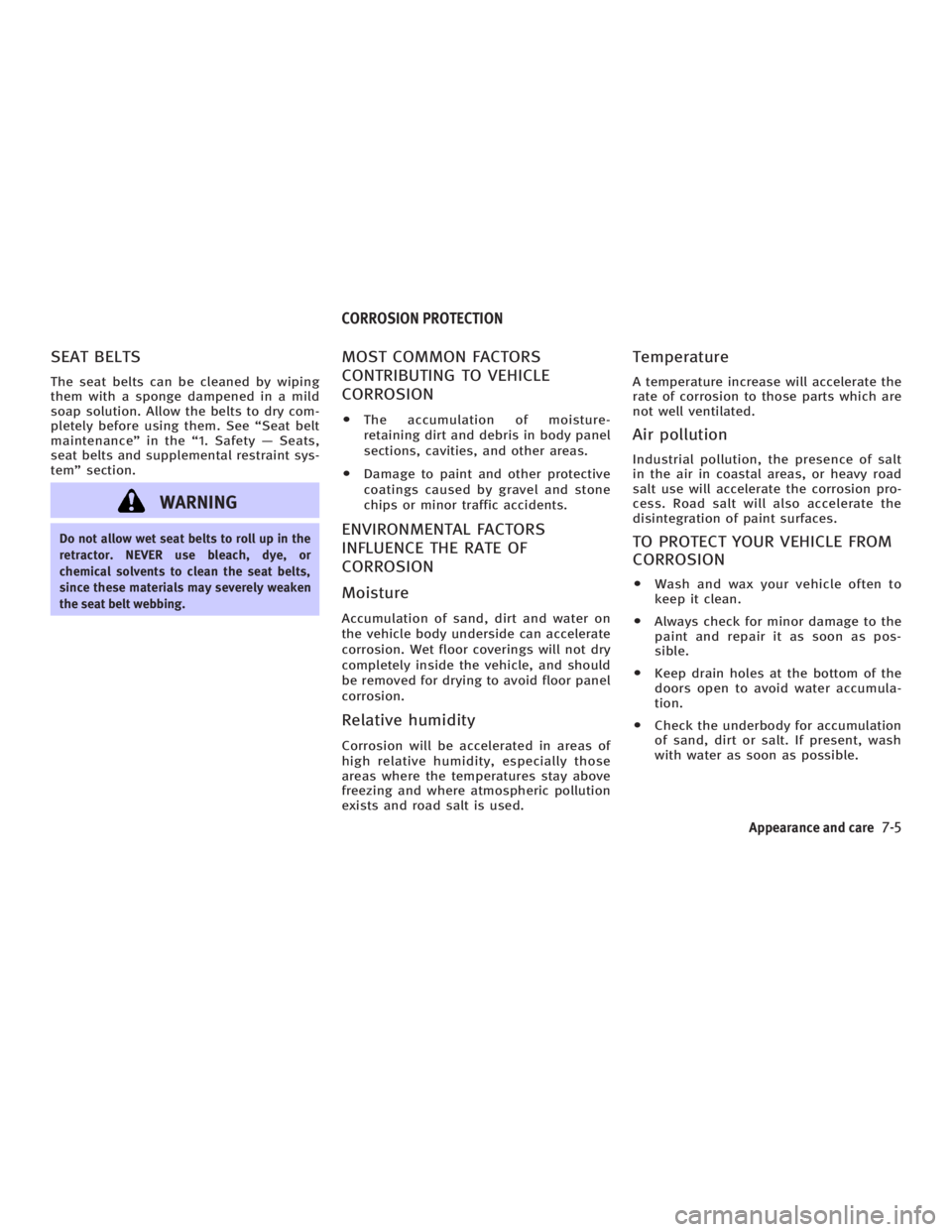
SEAT BELTS The seat belts can be cleaned by wiping
them with a sponge dampened in a mild
soap solution. Allow the belts to dry com-
pletely before using them. See ªSeat belt
maintenanceº in the ª1. Safety Ð Seats,
seat belts and supplemental restraint sys-
temº section.
WARNINGDo not allow wet seat belts to roll up in the
retractor. NEVER use bleach, dye, or
chemical solvents to clean the seat belts,
since these materials may severely weaken
the seat belt webbing. MOST COMMON FACTORS
CONTRIBUTING TO VEHICLE
CORROSION O The accumulation of moisture-
retaining dirt and debris in body panel
sections, cavities, and other areas.
O Damage to paint and other protective
coatings caused by gravel and stone
chips or minor traffic accidents.
ENVIRONMENTAL FACTORS
INFLUENCE THE RATE OF
CORROSION
Moisture Accumulation of sand, dirt and water on
the vehicle body underside can accelerate
corrosion. Wet floor coverings will not dry
completely inside the vehicle, and should
be removed for drying to avoid floor panel
corrosion.
Relative humidity Corrosion will be accelerated in areas of
high relative humidity, especially those
areas where the temperatures stay above
freezing and where atmospheric pollution
exists and road salt is used. Temperature A temperature increase will accelerate the
rate of corrosion to those parts which are
not well ventilated.
Air pollution Industrial pollution, the presence of salt
in the air in coastal areas, or heavy road
salt use will accelerate the corrosion pro-
cess. Road salt will also accelerate the
disintegration of paint surfaces.
TO PROTECT YOUR VEHICLE FROM
CORROSION O Wash and wax your vehicle often to
keep it clean.
O Always check for minor damage to the
paint and repair it as soon as pos-
sible.
O Keep drain holes at the bottom of the
doors open to avoid water accumula-
tion.
O Check the underbody for accumulation
of sand, dirt or salt. If present, wash
with water as soon as possible.CORROSION PROTECTION
Appearance and care
7-5
w 06.1.4/V35-D/V5.0
X
Page 259 of 344
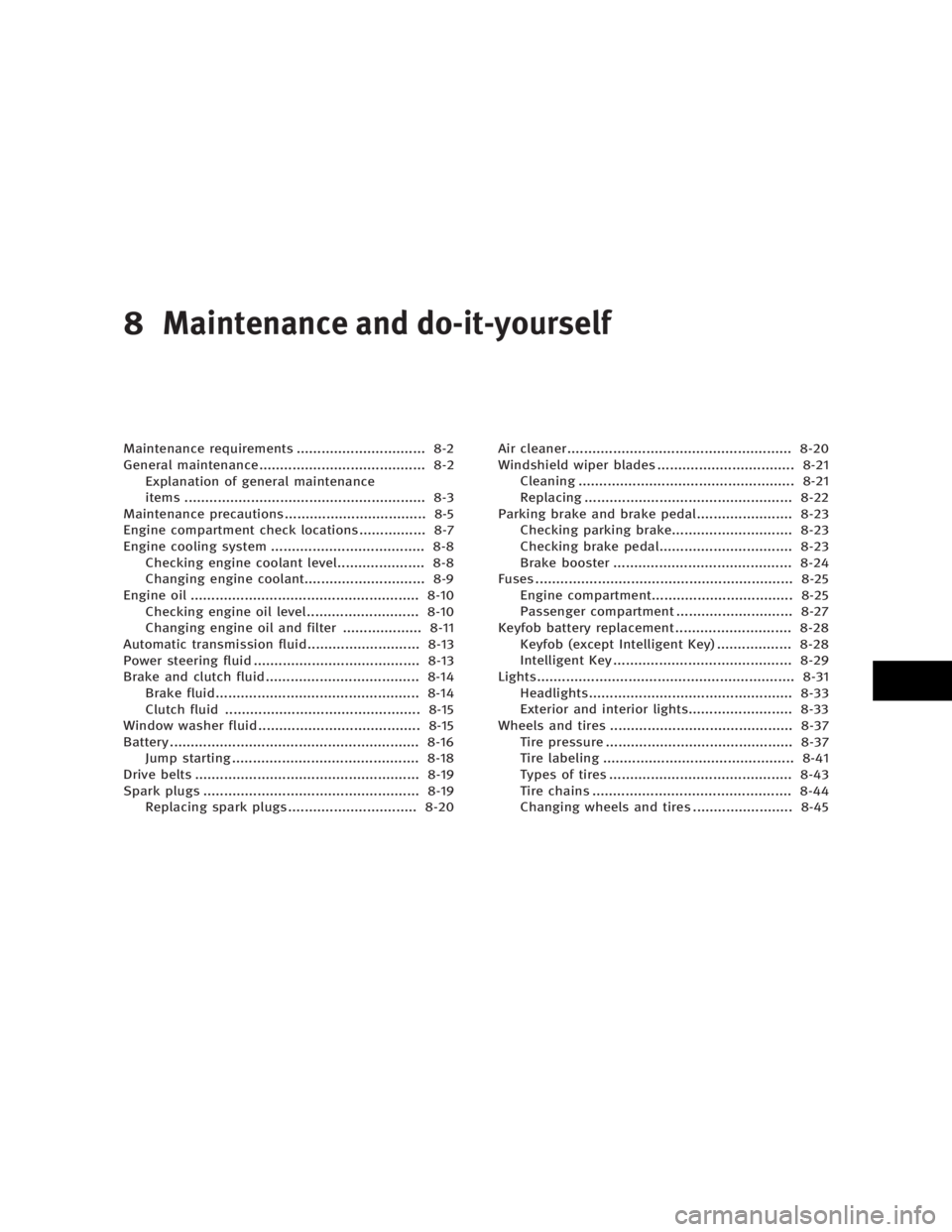
8 Maintenance and do-it-yourself Maintenance requirements ............................... 8-2
General maintenance........................................ 8-2
Explanation of general maintenance
items .......................................................... 8-3
Maintenance precautions .................................. 8-5
Engine compartment check locations................ 8-7
Engine cooling system ..................................... 8-8
Checking engine coolant level..................... 8-8
Changing engine coolant............................. 8-9
Engine oil ....................................................... 8-10
Checking engine oil level........................... 8-10
Changing engine oil and filter ................... 8-11
Automatic transmission fluid........................... 8-13
Power steering fluid ........................................ 8-13
Brake and clutch fluid..................................... 8-14
Brake fluid................................................. 8-14
Clutch fluid ............................................... 8-15
Window washer fluid ....................................... 8-15
Battery ............................................................ 8-16
Jump starting ............................................. 8-18
Drive belts ...................................................... 8-19
Spark plugs .................................................... 8-19
Replacing spark plugs ............................... 8-20 Air cleaner...................................................... 8-20
Windshield wiper blades ................................. 8-21
Cleaning .................................................... 8-21
Replacing .................................................. 8-22
Parking brake and brake pedal....................... 8-23
Checking parking brake............................. 8-23
Checking brake pedal................................ 8-23
Brake booster ........................................... 8-24
Fuses .............................................................. 8-25
Engine compartment.................................. 8-25
Passenger compartment ............................ 8-27
Keyfob battery replacement ............................ 8-28
Keyfob (except Intelligent Key) .................. 8-28
Intelligent Key ........................................... 8-29
Lights.............................................................. 8-31
Headlights................................................. 8-33
Exterior and interior lights......................... 8-33
Wheels and tires ............................................ 8-37
Tire pressure ............................................. 8-37
Tire labeling .............................................. 8-41
Types of tires ............................................ 8-43
Tire chains ................................................ 8-44
Changing wheels and tires ........................ 8-45
w 06.1.4/V35-D/V5.0
X
Page 262 of 344
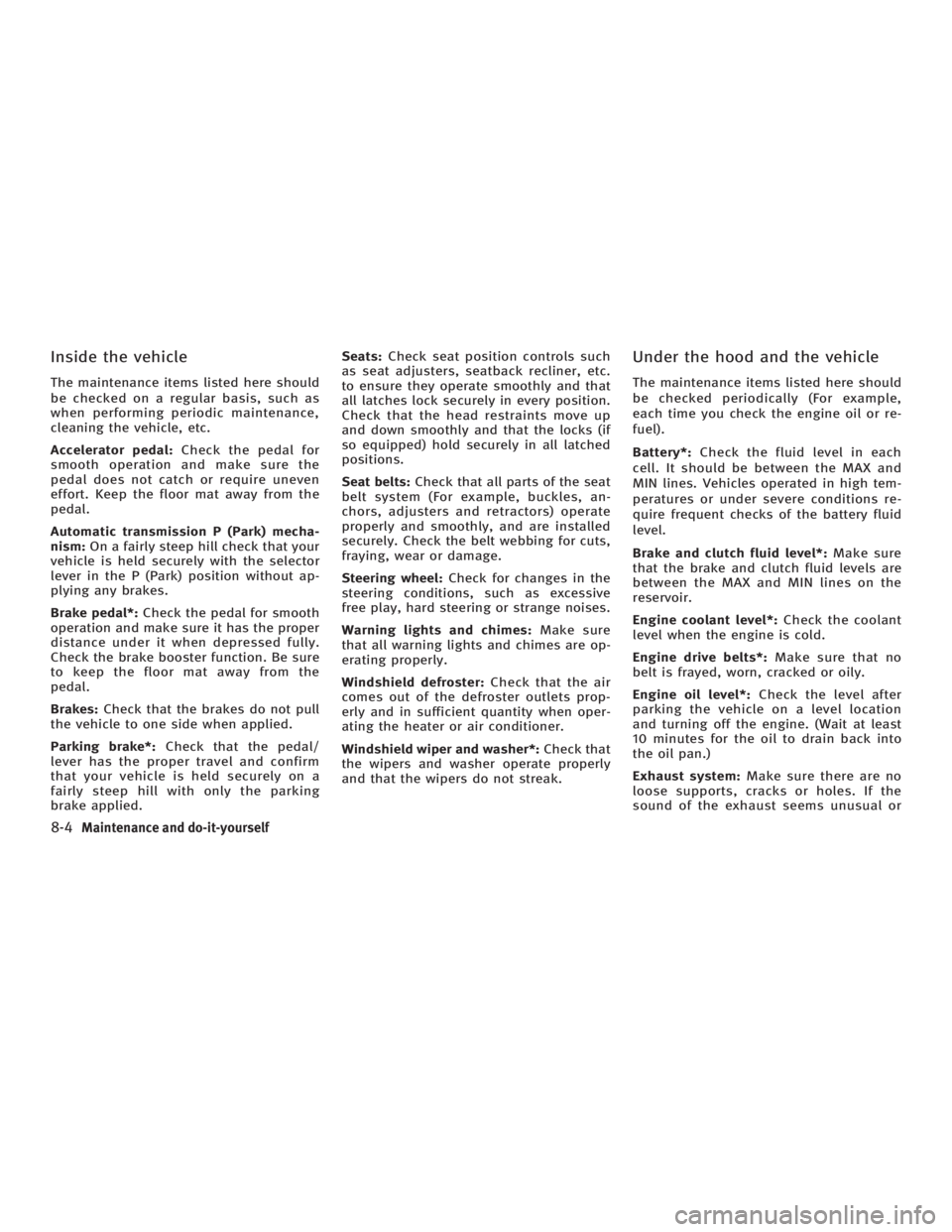
Inside the vehicle The maintenance items listed here should
be checked on a regular basis, such as
when performing periodic maintenance,
cleaning the vehicle, etc.
Accelerator pedal: Check the pedal for
smooth operation and make sure the
pedal does not catch or require uneven
effort. Keep the floor mat away from the
pedal.
Automatic transmission P (Park) mecha-
nism: On a fairly steep hill check that your
vehicle is held securely with the selector
lever in the P (Park) position without ap-
plying any brakes.
Brake pedal*: Check the pedal for smooth
operation and make sure it has the proper
distance under it when depressed fully.
Check the brake booster function. Be sure
to keep the floor mat away from the
pedal.
Brakes: Check that the brakes do not pull
the vehicle to one side when applied.
Parking brake*: Check that the pedal/
lever has the proper travel and confirm
that your vehicle is held securely on a
fairly steep hill with only the parking
brake applied. Seats: Check seat position controls such
as seat adjusters, seatback recliner, etc.
to ensure they operate smoothly and that
all latches lock securely in every position.
Check that the head restraints move up
and down smoothly and that the locks (if
so equipped) hold securely in all latched
positions.
Seat belts: Check that all parts of the seat
belt system (For example, buckles, an-
chors, adjusters and retractors) operate
properly and smoothly, and are installed
securely. Check the belt webbing for cuts,
fraying, wear or damage.
Steering wheel: Check for changes in the
steering conditions, such as excessive
free play, hard steering or strange noises.
Warning lights and chimes: Make sure
that all warning lights and chimes are op-
erating properly.
Windshield defroster: Check that the air
comes out of the defroster outlets prop-
erly and in sufficient quantity when oper-
ating the heater or air conditioner.
Windshield wiper and washer*: Check that
the wipers and washer operate properly
and that the wipers do not streak. Under the hood and the vehicle The maintenance items listed here should
be checked periodically (For example,
each time you check the engine oil or re-
fuel).
Battery*: Check the fluid level in each
cell. It should be between the MAX and
MIN lines. Vehicles operated in high tem-
peratures or under severe conditions re-
quire frequent checks of the battery fluid
level.
Brake and clutch fluid level*: Make sure
that the brake and clutch fluid levels are
between the MAX and MIN lines on the
reservoir.
Engine coolant level*: Check the coolant
level when the engine is cold.
Engine drive belts*: Make sure that no
belt is frayed, worn, cracked or oily.
Engine oil level*: Check the level after
parking the vehicle on a level location
and turning off the engine. (Wait at least
10 minutes for the oil to drain back into
the oil pan.)
Exhaust system: Make sure there are no
loose supports, cracks or holes. If the
sound of the exhaust seems unusual or
8-4 Maintenance and do-it-yourself
w 06.1.4/V35-D/V5.0
X
Page 263 of 344
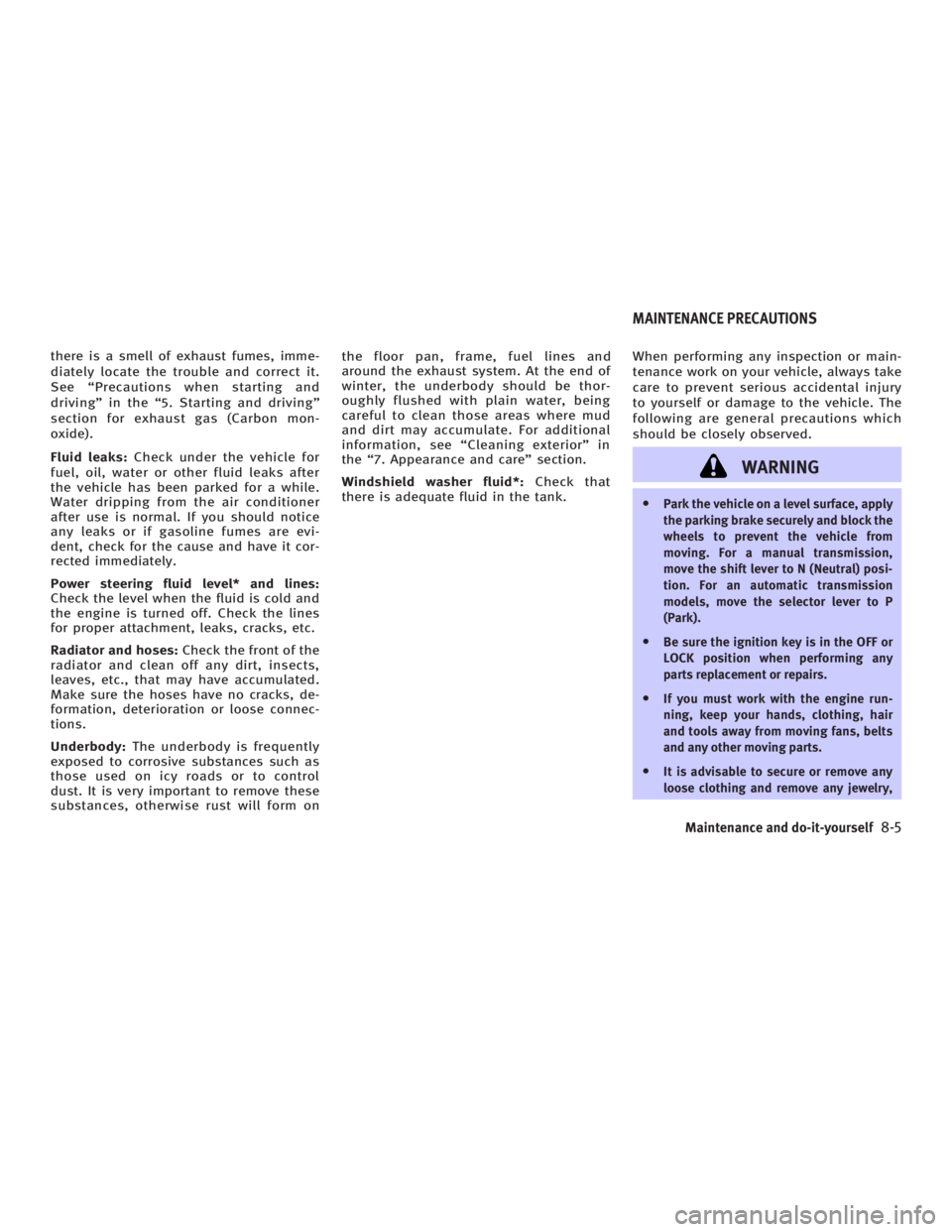
there is a smell of exhaust fumes, imme-
diately locate the trouble and correct it.
See ªPrecautions when starting and
drivingº in the ª5. Starting and drivingº
section for exhaust gas (Carbon mon-
oxide).
Fluid leaks: Check under the vehicle for
fuel, oil, water or other fluid leaks after
the vehicle has been parked for a while.
Water dripping from the air conditioner
after use is normal. If you should notice
any leaks or if gasoline fumes are evi-
dent, check for the cause and have it cor-
rected immediately.
Power steering fluid level* and lines:
Check the level when the fluid is cold and
the engine is turned off. Check the lines
for proper attachment, leaks, cracks, etc.
Radiator and hoses: Check the front of the
radiator and clean off any dirt, insects,
leaves, etc., that may have accumulated.
Make sure the hoses have no cracks, de-
formation, deterioration or loose connec-
tions.
Underbody: The underbody is frequently
exposed to corrosive substances such as
those used on icy roads or to control
dust. It is very important to remove these
substances, otherwise rust will form on the floor pan, frame, fuel lines and
around the exhaust system. At the end of
winter, the underbody should be thor-
oughly flushed with plain water, being
careful to clean those areas where mud
and dirt may accumulate. For additional
information, see ªCleaning exteriorº in
the ª7. Appearance and careº section.
Windshield washer fluid*: Check that
there is adequate fluid in the tank. When performing any inspection or main-
tenance work on your vehicle, always take
care to prevent serious accidental injury
to yourself or damage to the vehicle. The
following are general precautions which
should be closely observed.
WARNING O Park the vehicle on a level surface, apply
the parking brake securely and block the
wheels to prevent the vehicle from
moving. For a manual transmission,
move the shift lever to N (Neutral) posi-
tion. For an automatic transmission
models, move the selector lever to P
(Park).
O Be sure the ignition key is in the OFF or
LOCK position when performing any
parts replacement or repairs.
O If you must work with the engine run-
ning, keep your hands, clothing, hair
and tools away from moving fans, belts
and any other moving parts.
O It is advisable to secure or remove any
loose clothing and remove any jewelry,MAINTENANCE PRECAUTIONS
Maintenance and do-it-yourself
8-5
w 06.1.4/V35-D/V5.0
X
Page 265 of 344
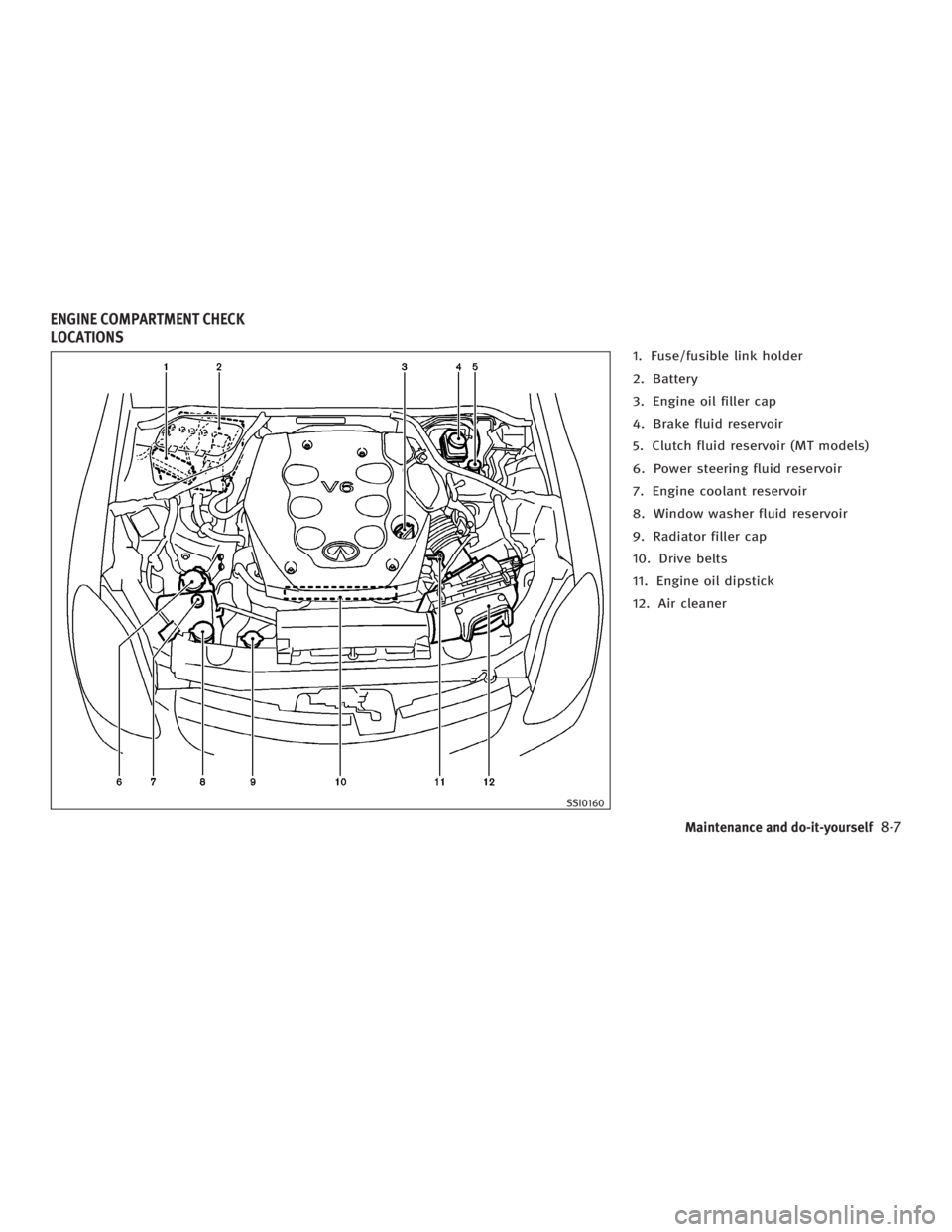
1. Fuse/fusible link holder
2. Battery
3. Engine oil filler cap
4. Brake fluid reservoir
5. Clutch fluid reservoir (MT models)
6. Power steering fluid reservoir
7. Engine coolant reservoir
8. Window washer fluid reservoir
9. Radiator filler cap
10. Drive belts
11. Engine oil dipstick
12. Air cleaner
SSI0160ENGINE COMPARTMENT CHECK
LOCATIONS
Maintenance and do-it-yourself
8-7
w 06.1.4/V35-D/V5.0
X
Page 267 of 344
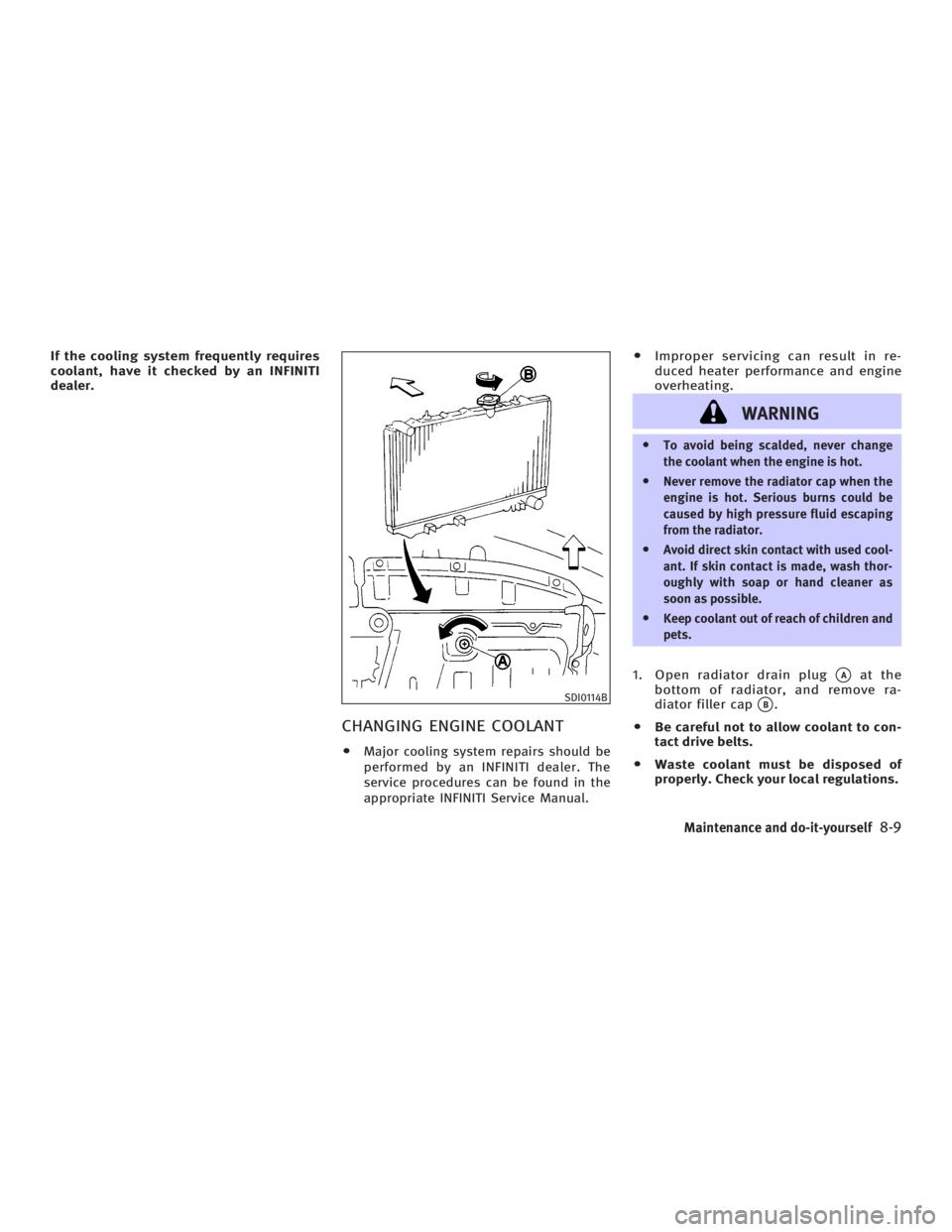
If the cooling system frequently requires
coolant, have it checked by an INFINITI
dealer.
CHANGING ENGINE COOLANT O Major cooling system repairs should be
performed by an INFINITI dealer. The
service procedures can be found in the
appropriate INFINITI Service Manual. O Improper servicing can result in re-
duced heater performance and engine
overheating.
WARNING O To avoid being scalded, never change
the coolant when the engine is hot.
O Never remove the radiator cap when the
engine is hot. Serious burns could be
caused by high pressure fluid escaping
from the radiator.
O Avoid direct skin contact with used cool-
ant. If skin contact is made, wash thor-
oughly with soap or hand cleaner as
soon as possible.
O Keep coolant out of reach of children and
pets.
1. Open radiator drain plug
q A
at the
bottom of radiator, and remove ra-
diator filler cap
q B
.
O Be careful not to allow coolant to con-
tact drive belts.
O Waste coolant must be disposed of
properly. Check your local regulations. SDI0114B
Maintenance and do-it-yourself
8-9
w 06.1.4/V35-D/V5.0
X
Page 277 of 344
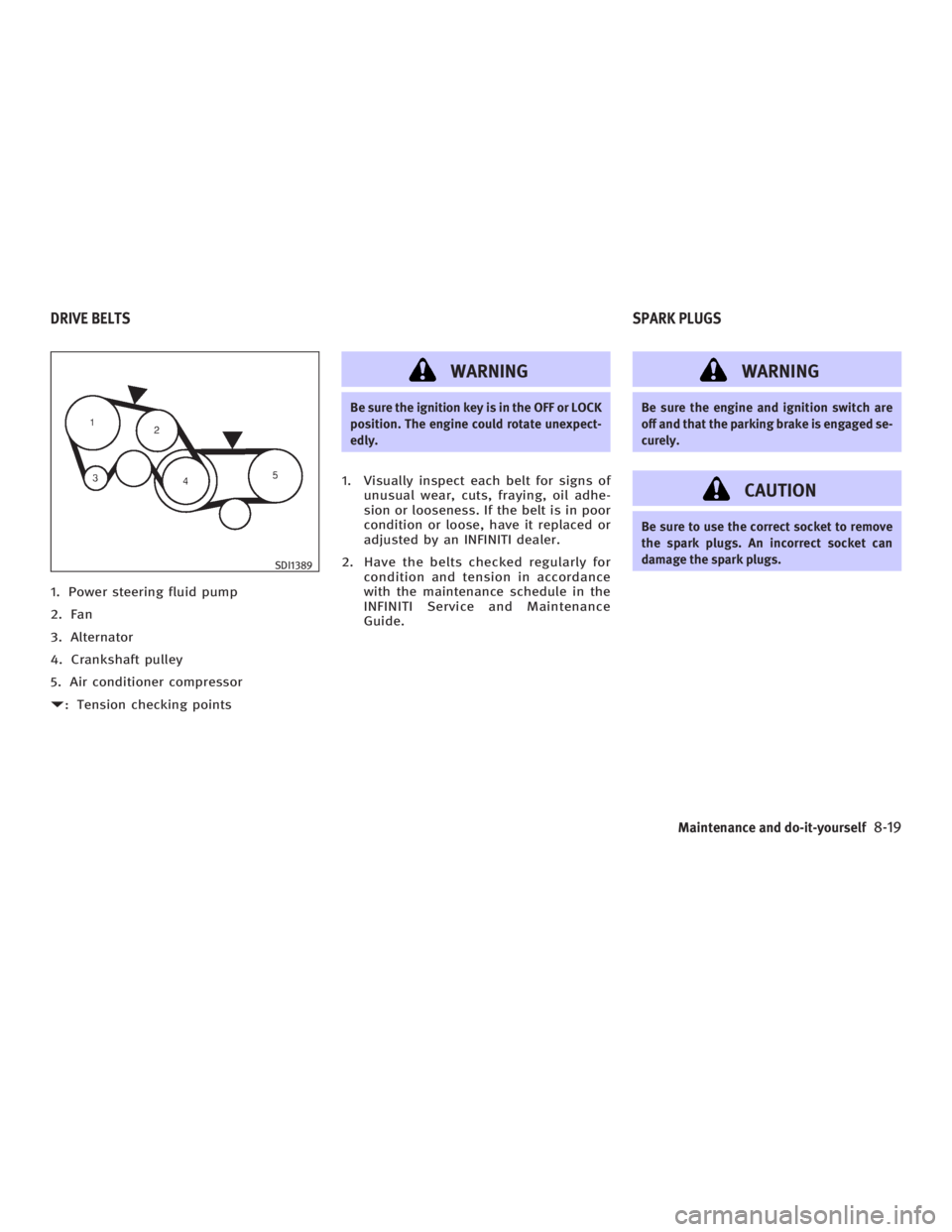
1. Power steering fluid pump
2. Fan
3. Alternator
4. Crankshaft pulley
5. Air conditioner compressor
D : Tension checking points WARNING Be sure the ignition key is in the OFF or LOCK
position. The engine could rotate unexpect-
edly.
1. Visually inspect each belt for signs of
unusual wear, cuts, fraying, oil adhe-
sion or looseness. If the belt is in poor
condition or loose, have it replaced or
adjusted by an INFINITI dealer.
2. Have the belts checked regularly for
condition and tension in accordance
with the maintenance schedule in the
INFINITI Service and Maintenance
Guide.
WARNING Be sure the engine and ignition switch are
off and that the parking brake is engaged se-
curely.
CAUTION Be sure to use the correct socket to remove
the spark plugs. An incorrect socket can
damage the spark plugs.SDI1389
DRIVE BELTS SPARK PLUGS
Maintenance and do-it-yourself
8-19
w 06.1.4/V35-D/V5.0
X